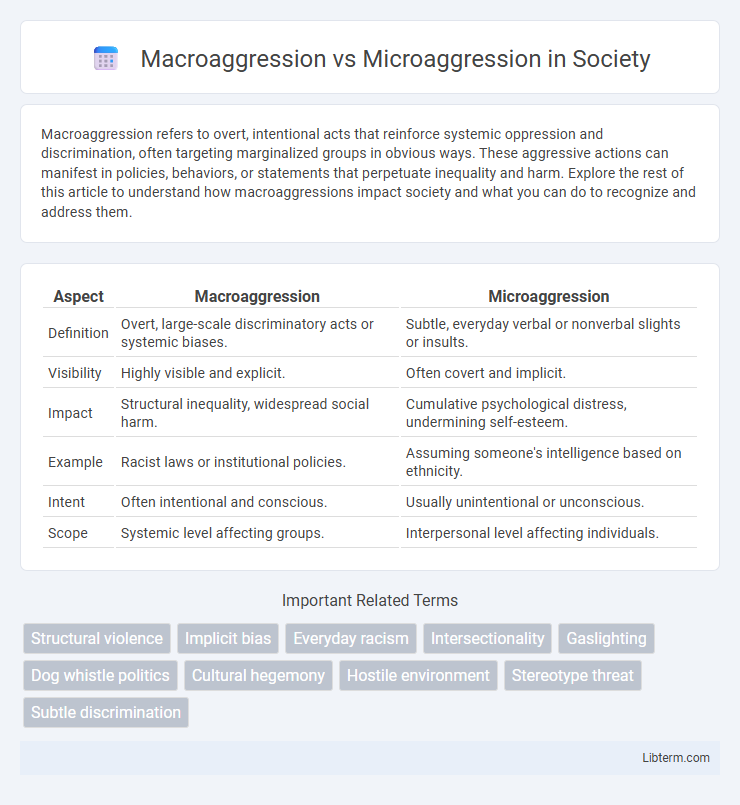Macroaggression refers to overt, intentional acts that reinforce systemic oppression and discrimination, often targeting marginalized groups in obvious ways. These aggressive actions can manifest in policies, behaviors, or statements that perpetuate inequality and harm. Explore the rest of this article to understand how macroaggressions impact society and what you can do to recognize and address them.
Table of Comparison
| Aspect | Macroaggression | Microaggression |
|---|---|---|
| Definition | Overt, large-scale discriminatory acts or systemic biases. | Subtle, everyday verbal or nonverbal slights or insults. |
| Visibility | Highly visible and explicit. | Often covert and implicit. |
| Impact | Structural inequality, widespread social harm. | Cumulative psychological distress, undermining self-esteem. |
| Example | Racist laws or institutional policies. | Assuming someone's intelligence based on ethnicity. |
| Intent | Often intentional and conscious. | Usually unintentional or unconscious. |
| Scope | Systemic level affecting groups. | Interpersonal level affecting individuals. |
Understanding Macroaggressions and Microaggressions
Macroaggressions are overt, large-scale acts of discrimination or hostility, often systemic and easily identifiable in policies or actions causing significant harm to marginalized groups. Microaggressions are subtle, everyday verbal or behavioral slights that communicate negative or prejudiced messages to individuals based on their identity, often unconscious but cumulative in impact. Understanding the distinction between macroaggressions and microaggressions is crucial for addressing both systemic inequality and interpersonal bias effectively.
Defining Macroaggressions: Broad Impacts
Macroaggressions are large-scale, systemic actions or policies that perpetuate inequality and discrimination across institutions and society. These broad impacts influence social structures, economic opportunities, and cultural norms, creating pervasive barriers for marginalized groups. Unlike microaggressions, which are subtle and interpersonal, macroaggressions operate at institutional and societal levels, reinforcing systemic bias.
What Are Microaggressions?
Microaggressions are subtle, often unintentional, verbal or behavioral slights that communicate negative or derogatory messages to marginalized groups. These everyday exchanges, such as backhanded compliments or dismissive comments, can accumulate over time to cause significant psychological harm. Unlike macroaggressions, which are overt and intentional acts of discrimination, microaggressions operate beneath the level of conscious awareness but reinforce systemic inequality.
Key Differences Between Macroaggressions and Microaggressions
Macroaggressions involve overt, intentional acts of discrimination or hostility typically perpetrated by dominant groups, often resulting in widespread social and systemic impact. Microaggressions are subtle, often unintentional verbal, behavioral, or environmental slights that convey derogatory or negative messages to marginalized individuals. Key differences include scale, intent, and visibility, with macroaggressions being explicit and socially recognized, while microaggressions are implicit and frequently overlooked.
Common Examples in Everyday Life
Macroaggressions often include systemic discrimination such as institutional racism in housing policies or unequal access to education. Microaggressions manifest as subtle verbal or behavioral slights like mispronouncing a person's name, assuming someone's capabilities based on gender, or making stereotypical comments about ethnicity. Both forms contribute to persistent social inequalities and emotional distress in marginalized communities.
Psychological Effects on Individuals and Communities
Macroaggressions, often manifesting as systemic discrimination or institutionalized bias, create pervasive psychological burdens such as chronic stress, anxiety, and feelings of powerlessness among marginalized communities. Microaggressions, subtle and often unconscious verbal or behavioral slights, accumulate over time to undermine individual self-esteem and foster a persistent sense of exclusion and alienation. Both forms of aggression contribute to heightened risks of depression, trauma, and social fragmentation, undermining mental health and community cohesion.
The Role of Intent versus Impact
Macroaggressions involve large-scale, overt discriminatory acts or institutional policies that systematically oppress marginalized groups, while microaggressions consist of subtle, often unintentional behaviors or comments that convey bias. The role of intent is less significant than impact in evaluating these interactions; microaggressions can perpetuate harm regardless of whether the perpetrator intended offense. Recognizing the impact prioritizes the experiences of those affected, emphasizing that harm caused by both macro and microaggressions demands accountability and systemic change.
Addressing Macroaggressions at Institutional Levels
Addressing macroaggressions at institutional levels requires comprehensive policy reforms that target systemic inequalities and discriminatory practices embedded within organizational structures. Implementing mandatory training programs on equity, diversity, and inclusion equips leadership and staff with the awareness and tools to identify and dismantle macroaggressive behaviors. Data-driven accountability measures, including transparent reporting systems and regular audits, ensure sustained institutional commitment to eradicating macroaggressions and fostering an inclusive environment.
Strategies to Recognize and Respond to Microaggressions
Recognizing microaggressions involves actively listening to the experiences of marginalized individuals and identifying subtle verbal, nonverbal, or environmental slights that communicate bias. Effective response strategies include calmly addressing the comment or behavior, educating the offender about its impact, and fostering open dialogue to promote awareness and inclusivity. Organizations can implement training programs to equip employees with skills to detect microaggressions and create supportive environments that encourage reporting and constructive feedback.
Fostering Inclusive Environments: Moving Forward
Fostering inclusive environments requires recognizing the broad impact of macroaggressions, which are overt, systemic acts of discrimination, alongside the subtle, everyday microaggressions that undermine marginalized groups. Developing comprehensive diversity training programs and implementing clear anti-discrimination policies help address both levels of aggression, promoting equity and psychological safety. Creating spaces that encourage open dialogue and accountability empowers individuals to identify and challenge these behaviors, advancing sustainable inclusivity in workplaces and communities.
Macroaggression Infographic

 libterm.com
libterm.com